
image Martin Desinde
Research Day: Which Bodie(s) in/for Space?
co-directed by Annick Bureaud and Manuela de Barros
Tuesday October 26th 2021
9h30 – 20h00
Centre Wallonie Bruxelles
127-129 Rue Saint-Martin, 75004 Paris
free entrance in the limit of available seats
registration required url du formulaire
Sommaire :
Introductions
Introduction, Annick Bureaud
Director Leonardo/Olats
Who goes into space? With which body (s)? What does space do to these bodies? Human flights or robotic missions? This largely sterile opposition is as old as astronautics, space astronomy and field planetology combined. Human flights, yes, but by whom? Robots, of course, but of what nature?
The term « human flights » brings up the image of a Man, a male human, the figure of those who have « The Right Stuff. » Thus, in 2019, the Extra Vehicular Activitiy of the International Space Station by two female astronauts could still generate the headline “All Women Crew”. It also means leaving behind the zoo of animals of all kinds, the greenhouses of various plants and the vast array of microorganisms that have always accompanied Humans on their extra-terrestrial journeys. As for robots and probes, their inorganic bodies are associated, remotely, with human pilots and scientists scattered all over the world — proposing another, collective, figure of the cyborg.
In line with the workshops organised by Leonardo/Olats, in collaboration with Manuela de Barros’ research programme at the University of Paris 8 and with the CNEAI, this study day brings together multiple and crossed voices of artists, theorists and scientists for a new approach to space in the Anthropocene era that takes the body and beings in a multidimensional and evolutionary vision.
It addresses the question of the body in extraterrestrial space understood as the human body in all its dimensions, the body of living non-humans (animals, plants), the surrogate bodies that are robots and celestial inorganic bodies of asteroids and planets.

Annick Bureaud is an independent art critic, curator and event organiser in the field of art and technosciences. She wrote numerous articles and contributes to the French contemporary art magazine art press. She organised many symposia, conferences and workshops among which Visibility – Legibility of Space Art. Art and Zero Gravity: The Experience of Parabolic Flight, project in collaboration between Leonardo/Olats and the International Festival @rt Outsiders, Paris, 2003. In 2009, she co-curated the exhibition (Un)Inhabitable? Art of Extreme Environments, Festival @rt Outsiders, MEP/European House of Photography, Paris. In 2018, she curated the Bourges Bandits-Mages Festival Mending the Fabric of the World. In 2019, she published-curated the online hypertext video capsule about the artwork Neotenous Dark Dwellers – Lygophilia by Robertina Šebjanič. In 2020, she initiated The Traveling Plant project. She is the director of Leonardo/Olats.
Introduction, Manuela de Barros
Assistant Professor in philosophy, aesthetics and theory of arts at the Paris 8 University
This study day is part of the research project entitled « Extension of the field of The Living and Open Intelligence » carried by EurArtec and part of the Master of Arts and Media Ecology of the TEAMeD research team of the University of Paris 8 Vincennes Saint-Denis. Participants will present projects and works specific to space exploration, a subject that Annick Bureaud, co-director of the project, has been studying and constructing from an art point of view for several decades.
For my part, this day is part of a long-term reflection on the relationships between arts, sciences and technologies, and the exploration of the tensions, reactions or organizations that this brings, whether political, geographical, mental or physical. It is also the continuation of a research on the relationship between science and fiction, and how this apparent opposition can be constructive and fruitful for creation, as well as for thinking about the world we inhabit and the one we are building for tomorrow. During this day, we will observe that our universe has expanded dramatically thanks to the conjunction of science, art and thought: around us by embracing multiple forms of life, outside of us and our alledged biological or cultural assignments, and beyond the cradle of planet Earth.
The body that is going to be discussed, starting both from spatial discovery strictly speaking, from anthropological or artistic projects, and above all from their interweaving, could be a planet, a meteorite, a modified human body, an algae or a robot.
The objective of this study day is to show how artistic creation and scientific research respond to each other, notably for reflection on the mutations and hybridizations of new forms of living and their environments which are the subject of this research project.

Manuela de Barros is Assistant Professor in philosophy, aesthetics and theory of arts at Paris 8 University. Her research concerns the aesthetics of contemporary art and new media ; relationships between arts, sciences and technologies ; the biological, anthropological and environmental modifications brought by technosciences ; the passages between sciences and fictional constructions (in art or in literature). She is the author of several publications including Magie et technologie (éditions UV).
Participants
Participants: Marie-Pier Boucher | Valérie Ciarletti | Kitsou Dubois | Ségolène Guinard | Flis Holland | Adriana Knouf | Minna Langström
Marie-Pier Boucher, Species of Time. Reflections on extra-terrestrial (in)temporalities
Species of Time. Reflections on extra-terrestrial (in)temporalities
Addressing the question of the body from cosmic considerations is a risk because there is not a unique body from which to situate ourselves. Defined in turn as normative, malleable, decomposable, transformable, cryonisable and even disposable; as that which can be the object of domestication, harvesting, breeding and cloning, that is to say, conceptualized as a medical subject, an organism, a spaceship, a representative of Noah’s ark, an extension of the senses, a cyborg, and a simulation, the body is a site of endless cosmic remappings.
However, the body, as Donna Haraway reminds us in her famous article Situated Knowledges, is an agent, and not a resource to be mapped and appropriated. How then can we grasp the agency of the “spatial body”? In order to avoid the pitfall of “projecting dangerous desires onto an alien other” (Halberstam, 2018), Species of Time questions the spatial body at the intersection of materiality and performativity. Outer space is indeed a place where bodies are made real and possible, actualized as we know them and virtualized in their potential metamorphoses. Species of time invests this double reality of the body through the examination of the new forms of temporalities that emerge in the experience of different gravitational fields. Informed by reports and testimonies of artists who signal a new feeling of time brought about by the experience of different gradients of gravity, Species of Time posits the question of the “spatial body” within a regime of temporality by interrogating the chrono-bodily materializations provoked by outer space.
Marie-Pier Boucher

Assistant Professor of Media Studies at the Institute of Communication, Culture, Information, and Technology + iSchool at University of Toronto, Mississauga
Marie-Pier Boucher works on the artistic exploration of science and technology, with a specific focus on the design of environments built to sustain life in extreme environments. She is co-editor of Being Material (MIT Press, 2019), Heteropolis (2013), and Adaptive Actions Madrid (2010). Boucher is the lead convener of the Space Media research group at the McLuhan Center for Culture and Technology. She has exhibited collectively at Centre George Pompidou (2021), Tokyo Wonder Site (2014), Leonard & Bina Ellen Gallery (2010) and Madrid Biennale (2010). Her research residencies include: NASA, Johnson Space Center, 2014; Banff Center 2011; Max Planck Institute for the History of Science (2010), and SymbioticA: Center for Excellence in Biological Arts (2006). She is currently an Assistant Professor at the Institute of Communication, Culture, Information, & Technology (ICCIT) and at the Faculty of Information at the University of Toronto.
adaptiveactions.net – kosmicainstitute.com – instagram.com/adaptiveactions/
Valérie Ciarletti, Searching for Traces of Life in the Martian Subsurface
Searching for Traces of Life in the Martian Subsurface

ExoMars Rover (modèle de vol), chez Airbus lors de la campagne d'étalonnage du radar WISDOM, image © Max Alexander, Airbus
The main objective of the ExoMars mission of the European Space Agency (ESA) in collaboration with the Russian Space Agency Roscosmos, which will leave for Mars in 2022, is to search for fossil traces of possible primitive life. While the conditions at the Martian surface may have been favorable to the emergence of life more than 4 billion years ago, they have become very hostile and it is therefore in the subsurface of the planet that the search will focus. The Rosalind Franklin rover of the ExoMars mission was built to take samples from the subsurface, up to 2 m deep, and to analyze them on Mars inside its on-board laboratory. In order to guide the drilling operations to areas of interest, the WISDOM radar was designed to reveal the structures buried beneath the surface in a non-destructive manner and to understand the geological evolution of the studied area.
The various instruments selected for the mission have been built and tested; they are now integrated to the mission rover. The scientific teams are preparing to collaborate as effectively as possible to carry out this investigation on Mars from Earth.
Valérie Ciarletti

Valérie Ciarletti, image © Pascal Gely
Deputy Director of LATMOS, Lead scientist of the WISDOM radar of the ExoMars Mission
Valérie Ciarletti is a full professor at UVSQ (Université Versailles Saint-Quentin) and Deputy Director of LATMOS (Laboratoire Atmosphères, Observations Spatiales), the laboratory in which she carries out her research activities.
After an engineering degree from ECP obtained in 1984, she continued with a thesis on the propagation of electromagnetic waves in natural environments. For the past twenty years, she worked on the characterization of the subsurface of planets and small bodies of the solar system by electromagnetic techniques that allow to reveal the structures buried under the surface.
She is the scientific leader of the WISDOM radar which will land on Mars in 2023 and will sound the subsurface of the planet along the rover path.
Kitsou Dubois, Modified Body in Microgravity: Complexity and paradoxes
Modified Body in Microgravity : Complexity and Paradoxes.
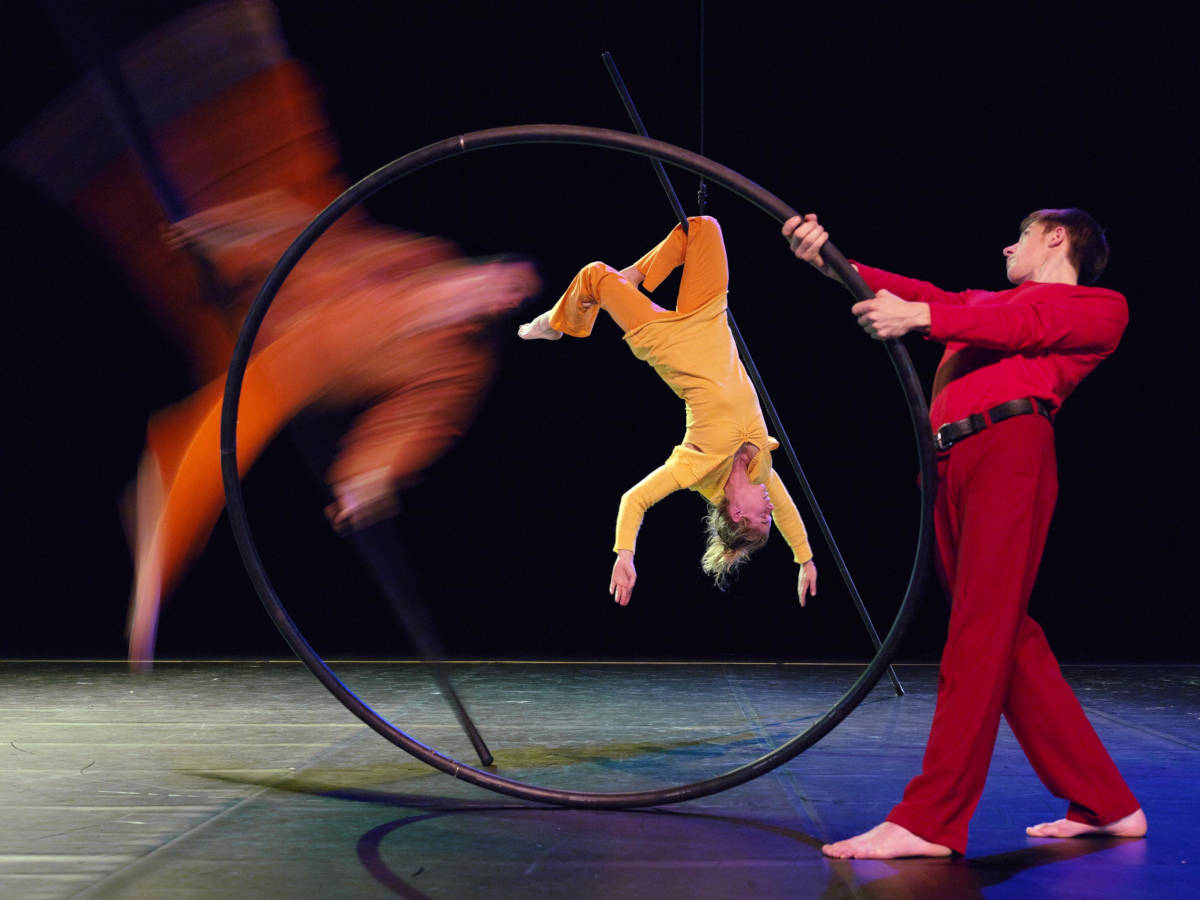
Kitsou Dubois, "Traversées" avec Damien Fournier Boris Gibé et Chloé Moglia, photo Quentin Bertoux
The absence of gravity changes the sensation of the body. The points of reference become virtual, the body expands. It oscillates between hypersensitivity and loss of sensitivity. There is nothing, no gravity, no standing point, just one’s body and a feeling of endless movement. Paradoxical sensations arise between emptiness and fullness, absence and presence, loss and anchoring, pleasure and fear, speed and slowness.
The experience of microgravity creates both a feeling of containing immersion like being in the matrix while being in an environmental disorder due to the loss of points of reference…
As a choreographer and researcher in dance, I revisit the fundamental gestures of dance from this experience of another space-time. Its representation on earth questions creative practices (experimentation in flight, in water, on circus apparatus, with sensory sensors), choreographic writing (linked to states of the body), the scenic space (immersion in image and sound) and the shifting of artistic forms (from dance to circus, including video installations and in-situ).
For me, it is about « taking » the audience into another relationship to time and space, by associating the notion of flight and lightness with the paradoxes and complexity of this experience. Indeed, the body of the dancer in microgravity is a powerful metaphor for the contemporary body. We are immersed in networks of information that are like sensitive endings that run through our body. The body, although heavy, is as if lifted, suspended from this world which surrounds us which becomes fluid or even liquid and which escapes us. Standing points become virtual in this world where technology gives us the illusion of being everywhere.
By putting the dancing body at the center of dispositifs that create immersive situations, I make the audience feel, through bodily empathy, the stretching of time and the expansion of space. My shows or my installations invite you to see and feel with your body the existence of other possible environments and states of being, which can be both very close and very far from us.
Kitsou Dubois
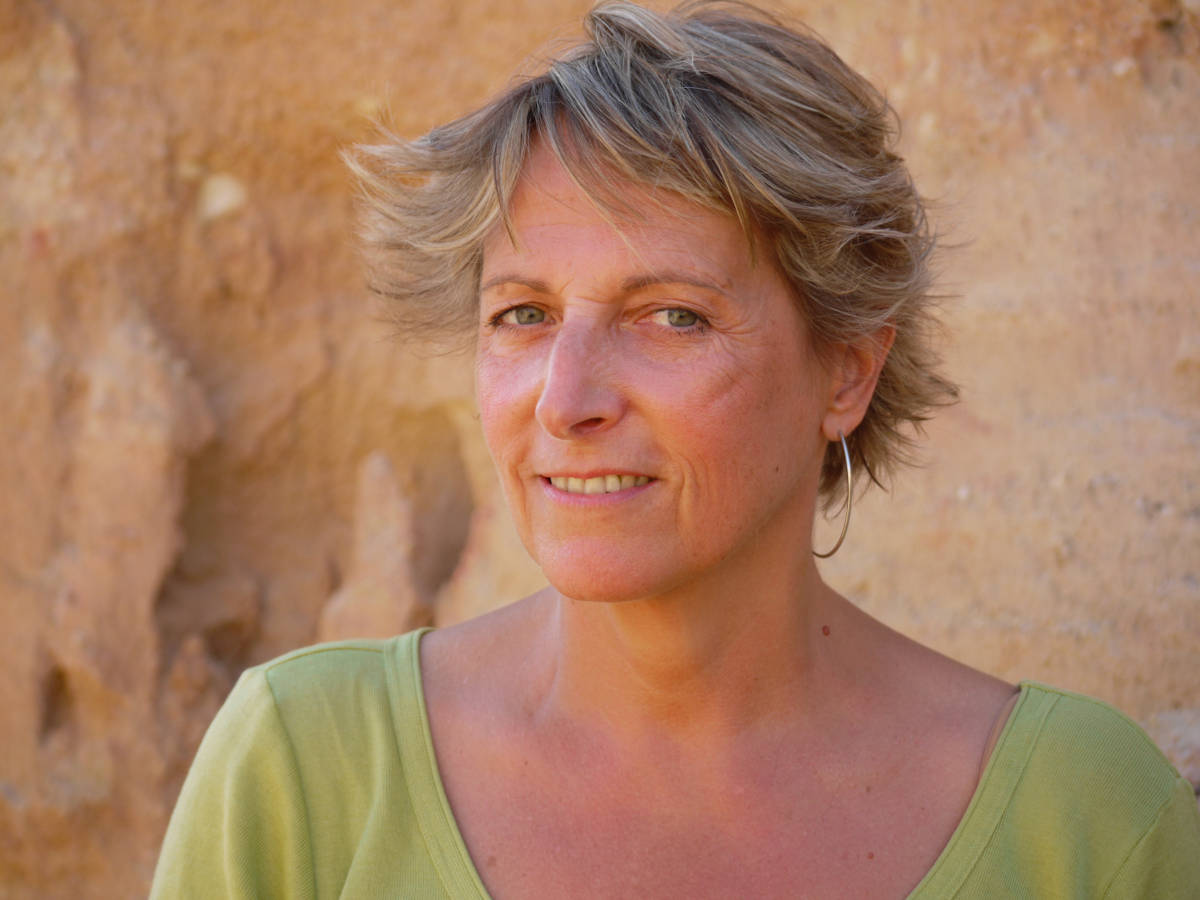
Kitsou Dubois, image © Diane Delehaye
French Choreographer, Dance Researcher, Artistic Director of « Ki Productions »
Kitsou Dubois is a French Choreographer, Dance Researcher, Artistic Director of «Ki Productions». In 1990, Kitsou Dubois, choreographer and researcher in dance, became the first artist to experience weightlessness in parabolic flight with the French Space Agency (CNES). Since then, Kitsou has flown on a series of 21 parabolic flights.
In her creations, from stage choreographies to video installations or hybrid productions, Kitsou uses her experience and knowledge of weightlessness to explore movement, perception of the environment and also the sensation of time, the relation to matter, the relation to others and the poetry of an environment where all familiar references seem to have been transformed.
She works with performers (dancers and acrobats) in environments where the sensation of gravity has been altered: in water, in parabolic flights, in virtual reality set-ups (with sound and sensorial sensors) and also works closely with researchers in science and technology.
In her artistic approach, she works, from the dance gesture perspective, on the legibility of another space-time « nor heavy, nor light ». She made dream-like pieces which trouble the perception of the audience. Movements alternate between losing point of reference and anchoring. A connection is made between the bodies of the dancers and that of the spectators, uniting both in a common vertigo.
www.kitsoudubois.com
Ségolène Guinard, Compos(t)ing the space body: human and non human lives inside the capsule
Compos(t)ing the space body: human and non human lives inside the capsule
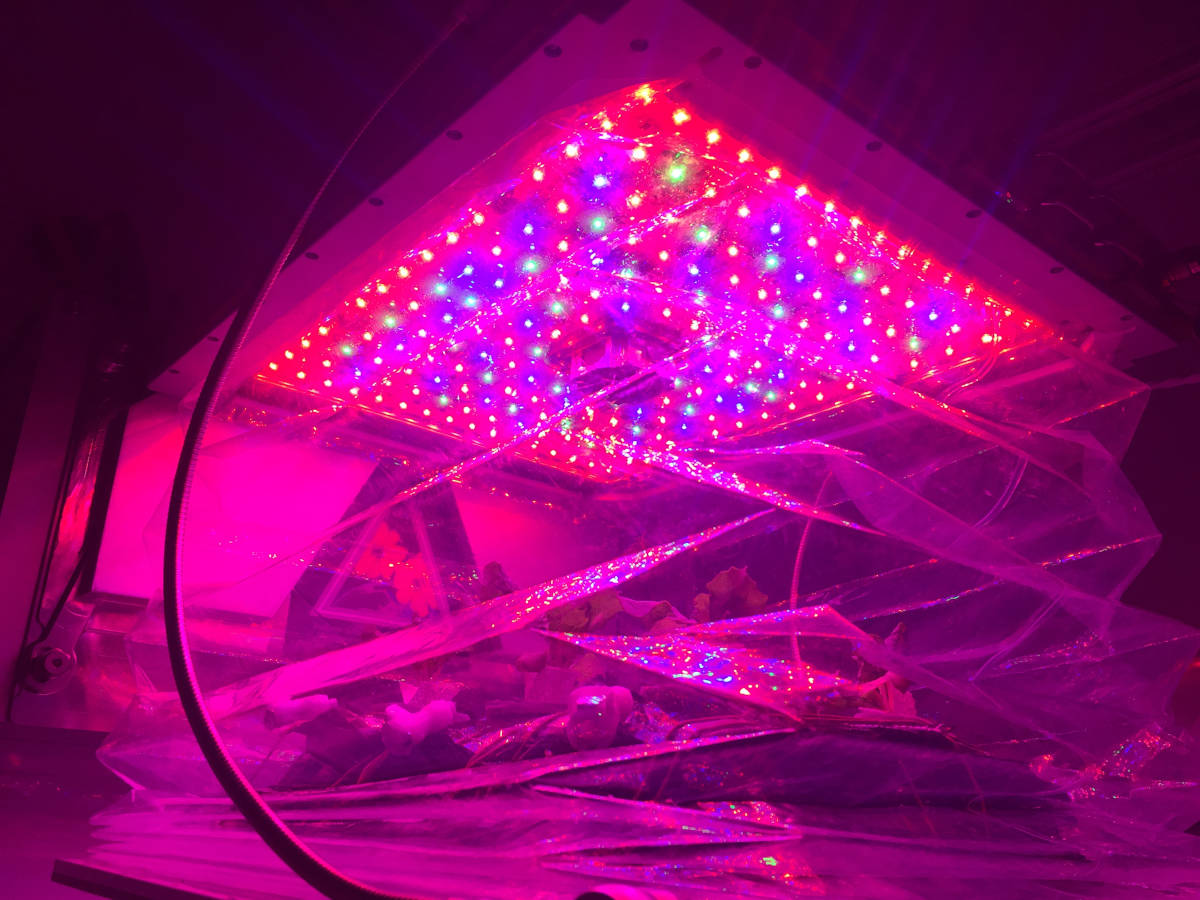
Expérience VEGGIE, Kennedy Space Center
Since the beginnings of human space flight, many space agencies and research programs have considered using plants and microalgae to enable the recycling of the atmosphere and organic matter on board space stations, and even the production of food.
These so-called « bio-regenerative » life support systems add to the abiotic physicochemical components of life support systems, the products of the activity of other living beings – thus constituting multispecies artificial environments.
If these habitats and experiences have mainly been deployed on Earth, giving rise to some experiments in plant culture in space, they invite us to an exercise that is both descriptive and speculative. Based on the example of these hermetic interiors, and the testimonies gathered around these research programs, this presentation proposes a reflection on the multi-specific life forms within the prosthetic exo-worlds that constitute the spatial habitats, a process to which we can give the name of capsular existence.
Ségolène Guinard

Ségolène Guinard
Ph.D Candidate in anthropology at McGill University and in philosophy at University Paris 8 Vincennes Saint-Denis.
Ségolène Guinard is a Ph.D Candidate in anthropology at McGill University and in philosophy at University Paris 8 Vincennes Saint-Denis. She is a member of the independent research group Stasis based in Montreal, as well as of the NébulX project, an online journal bringing together works at the intersection of fiction and the anthropology of technologies. In her research, she explores issues related to life in extreme environments, speculative fiction and radical criticism, as well as the practices of sensory ethnography through sound and image.
Flis Holland, Subserotic Bulge
Subserotic Bulge

In 2019 an iron meteorite was filed to dust, stirred into cream, and fed to 36 people. Flis’s uterus was rife with tumours soon after. Their belly swelled as a fleshy block pushed its way out at astonishing speed. From the first poke of a finger, to WebMD, to x-rays, every diagnostic tool came up short. But Flis’s telling of it is rather different to the medical notes.
Subserotic Bulge is a documentary that veers into sci-fi, and it’s not always clear which part is which. The video is the latest in a series in which Flis tentatively explores a new relationship to meteorites and asteroids.
In the early 2000s Flis started a career in the space industry, but lost all passion for it after the sexual misconduct of a professor. Their subject specialism was asteroid defence systems. Now, Flis is repurposing one such tool: bio-eaters, rock-eating microbes that avert crisis – very slowly – by digesting it.
Flis Holland

Flis Holland
Artist, Finnish Academy of Fine Arts
Flis Holland (FI/UK) is an artist from the Finnish Academy of Fine Arts, who uses sci-fi to find new ways to talk about crisis. They work with live performance, video, and text. Recent highlights include a residency at Finnish Cultural Institute in New York (US), a solo show « Gravity Doesn’t Keep You Down I Do » at Kosminen (FI), and a commissioned video « Subserotic Bulge » for Frame (FI). Their depressing short story « Sigh-fi » was published by Kontur journal.
Adriana Knouf, Tranxxeno Entanglements: On the Audacity of Imagining Transgender People in Space
Tranxxeno Entanglements : On the Audacity of Imagining Transgender People in Space.

Knouf-Adriana, "TX-1", image courtesy of the artist
As far as we know there have been no transgender people in space. Yet transgender people, as well as others who engage in extensive body modification necessary for survival such as disabled folx, might be the most suited for space travel given our somatic experiences of deep xenological transformations.
Such transformations will likely be required for survival and thriving both in extraterrestrial as well as future terrestrial environments.
I am exploring these issues through projects in my tranxxeno lab, a nomadic artistic research laboratory that investigates the productive entanglements between entities trans and xeno.
The first project, entitled « TX-1 », launched fragments of my hormone replacement medications to the International Space Station and marked the first-known time that elements of the transgender experience orbit the earth.
The second project-in-progress, « Xenological Entanglements. 001: Eromatase » considers self-experimentation, genetic modification, and DIY space medicine research. These projects lead us to consider the audacity of queer and transgender futures in space, questions of more-than-human enhancement that connect to the historical legacy of the cyborg, and are part of my research into xenology, or the study, analysis, and development of the strange, the alien, the other.
Adriana Knouf

Adriana Knouf
Artist/Writer/Xenologist; Independent artist
Adriana Knouf, PhD (US) works as an artist, writer, and xenologist. She engages with topics such as wet media, space art, satellites, radio transmission, non-human encounters, drone flight, queer and trans futurities, machine learning, the voice, and papermaking. She is the Founding Facilitator of the tranxxenolab, a nomadic artistic research laboratory that promotes entanglements among entities trans and xeno. Adriana regularly presents her artistic research around the world and beyond, including a work that has flown aboard the International Space Station. She was recently a Biofriction artist-in-residence at the Kersnikova Institute in Ljubljana, Slovenia.
Adriana is currently an artist-in-residence at Waag in Amsterdam, the Netherlands as part of the Art4Med consortium. She lives and works in Amsterdam.
Minna Långström, A Mars Exploration Into the Image - the background research of the film "The Other Side of Mars"
A Mars Exploration Into the Image - the background research of the film "The Other Side of Mars"

Minna Längström, "The Other Side of Mars"
The documentary The Other Side of Mars presents a discussion about the virtuality and materiality of images, in the context of Nasa’s Mars missions and related imagery. Witnessing the Mars Science Laboratory researchers’ close-up engagement with the Martian terrain during the making of the film brought about questions about the promises and limits of photography, interpretation of an inaccessible place via 2D-imagery, the role of perception, and the scientific value of imaging.
The first photographic meeting with the Martian surface took place just decades ago, and although there were reliable data evidence of Martian atmosphere and surface conditions speaking against these life forms, it took an orbital photograph to finally settle the last remaining ambiguities on this issue. The history of the exploration of Mars, in particular, is full of assumptions colored by our desires, which by no means ended with the first (telescope or spacecraft) photographic images of the planet.
From the early days of Martian photography, cameras and other photographic technology has become an increasingly pervasive part of the various kinds of tools the spacecraft are equipped with. Today NASA has whole units devoted to scientific photography, and the various applications of images as increasingly complex tools makes imaging itself emerge as a science in its own right. The background research and the material accumulated during the production of the film on Martian photography can also support a larger discussion about our past, present and future relationship to images in general.
Several of the researchers and engineers interviewed for the film are female, and part of the background research was devoted to the history of women in Astronomy and space exploration, and what the circumstances are like today for women in these fields.
Minna Långström

Minna Längström
Artist filmmaker, MFA
Minna Långström is a media artist and filmmaker from Helsinki, Finland. Her artistic work consists of participatory cinematic installations, short films and documentaries. Her work processes tend to be extensively researched and interdisciplinary. Her latest film The Other Side of Mars (56 min, 2019) brought her in contact with geologists, astrobiologists and Nasa engineers involved with the current Mars missions. Premiering at the DocPoint Documentary Film Festival 2019, and screened at festivals around the world, the film looks at the role of images in these missions. Her previous films and artwork have been selected to numerous film festivals and exhibited at museums such as Kiasma Museum of Contemporary Art and Frankfurter Kunstverein and in galleries such as InterAccess gallery in Toronto. Långström was an assistant professor in Moving Image at the Academy of Fine Art in Helsinki 2008-2012, where she also developed course concepts critically connecting media art, science and technology.She has been an artist in residency at FACT, Liverpool, IASPIS, Stockholm and Space Studios for Art and Technology in London.
http://www.minnalangstrom.net
https://napafilms.fi/mars-kuvien-takaa-the-other-side-of-mars-2019/
Videos
Video recordings of the Research Day, on YouTube below or on Vimeo
Introduction Annick Bureaud & Manuela de Barros
Ségolène Guinard, Compos(t)er le corps spatial : vies humaines et non-humaines à l'intérieur de la capsule
Kitsou Dubois, Corps modifié en microgravité : Complexité et paradoxes
Marie-Pier Boucher, Espèces de temps. Réflexions sur les (in)temporalités extra- terrestres
Space Bodies - Corps Spatial - Discussion avec A. Bureaud, M. de Barros, S. Guinard, K. Dubois et M.P. Boucher
Flis Holland, Subserotic Bulge
Adriana Knouf, Tranxxeno Entanglements: On the Audacity of Imagining Transgender People in Space
Space Bodies - Corps Spatial – Discussion with Annick Bureaud, Manuela de Barros, Flis Holland, Adriana Knouf
Valérie Ciarletti, À la recherche de traces de vie dans le sous-sol martien
Minna Långström A Mars Exploration Into the Image - the background research of the film "The Other Side of Mars"
Space Bodies - Corps Spatial – Discussion with Annick Bureaud, Manuela de Barros, Valérie Ciarletti, Minna Långström
Galerie

Ségolène Guinard - image courtesy Mamadou-Gningue-Elisa-Birnie-Scott

Kitsou Dubois - image courtesy Mamadou-Gningue-Elisa-Birnie-Scott
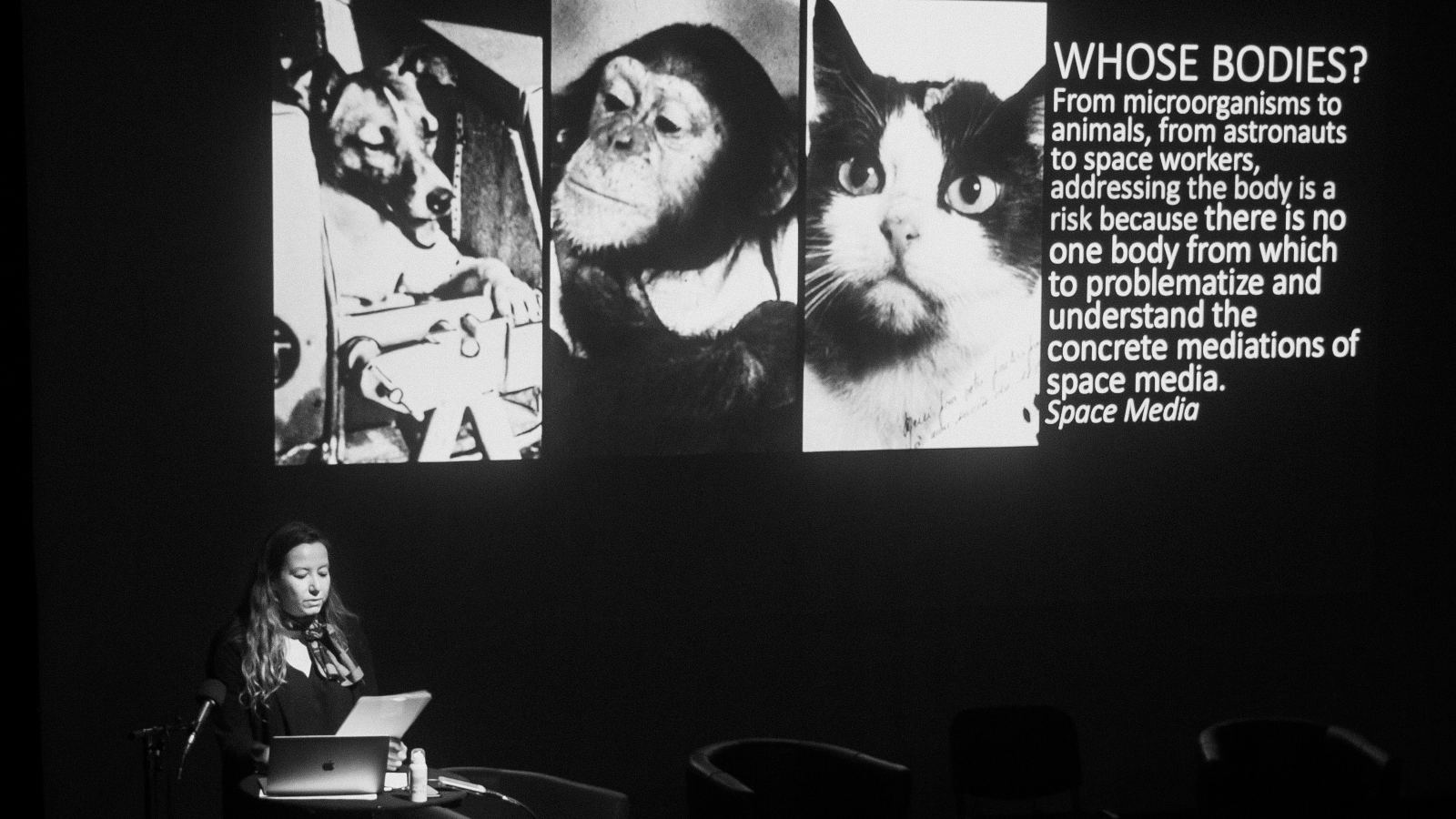
Marie-Pier Boucher - image courtesy Mamadou-Gningue-Elisa-Birnie-Scott

A. Bureaud, S. Guinard, M. de Barros, M-P. Boucher, K. Dubois - image courtesy Mamadou-Gningue-Lou-Mollet
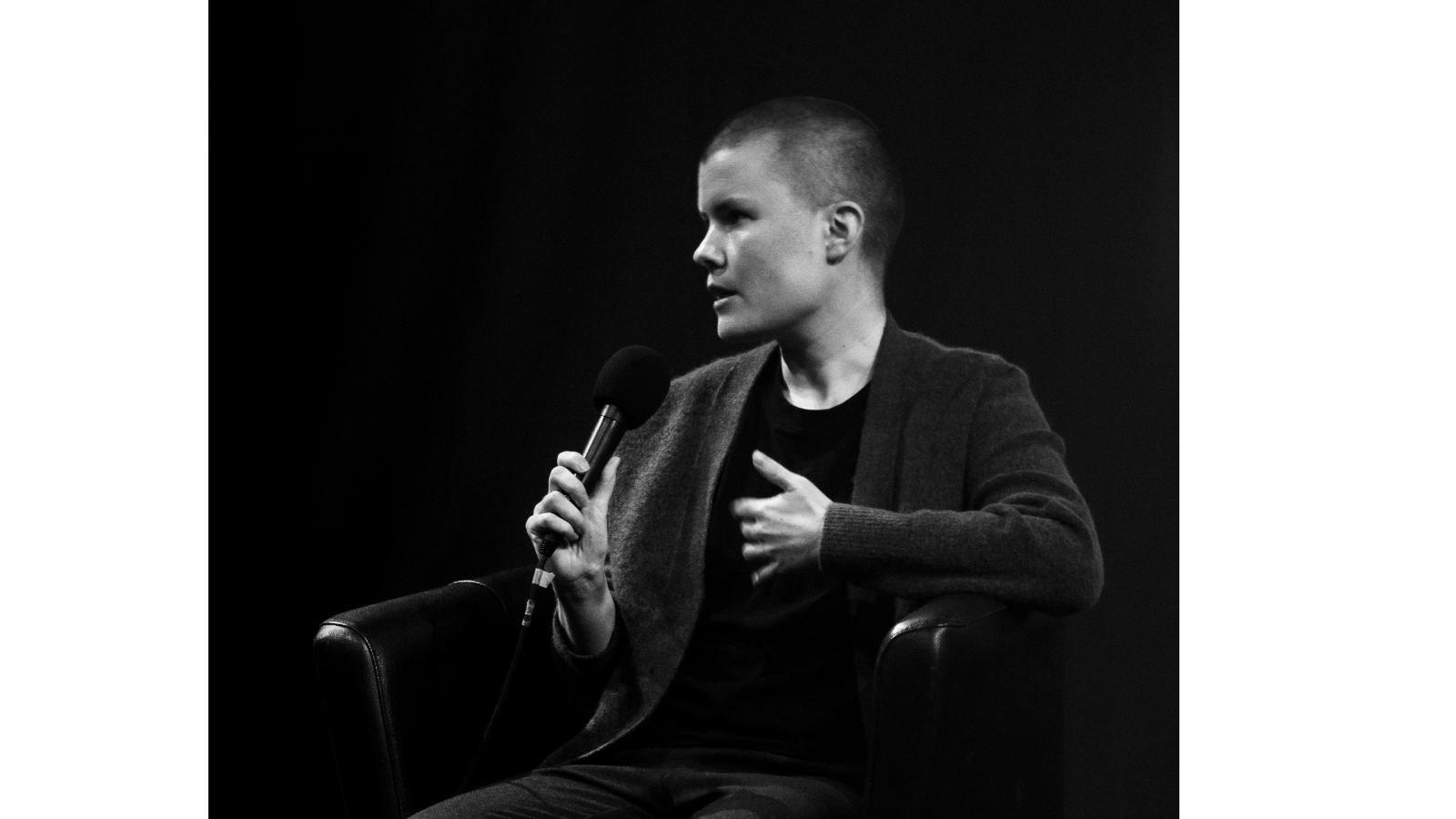
Flis Holland - image courtesy Mamadou-Gningue-Elisa-Birnie-Scott

Adriana Knouf - image courtesy Mamadou-Gningue-Elisa-Birnie-Scott

A. Bureaud, Flis Holland, Adriana Knouf, M. de Barros - image courtesy Mamadou-Gningue-Lou-Mollet
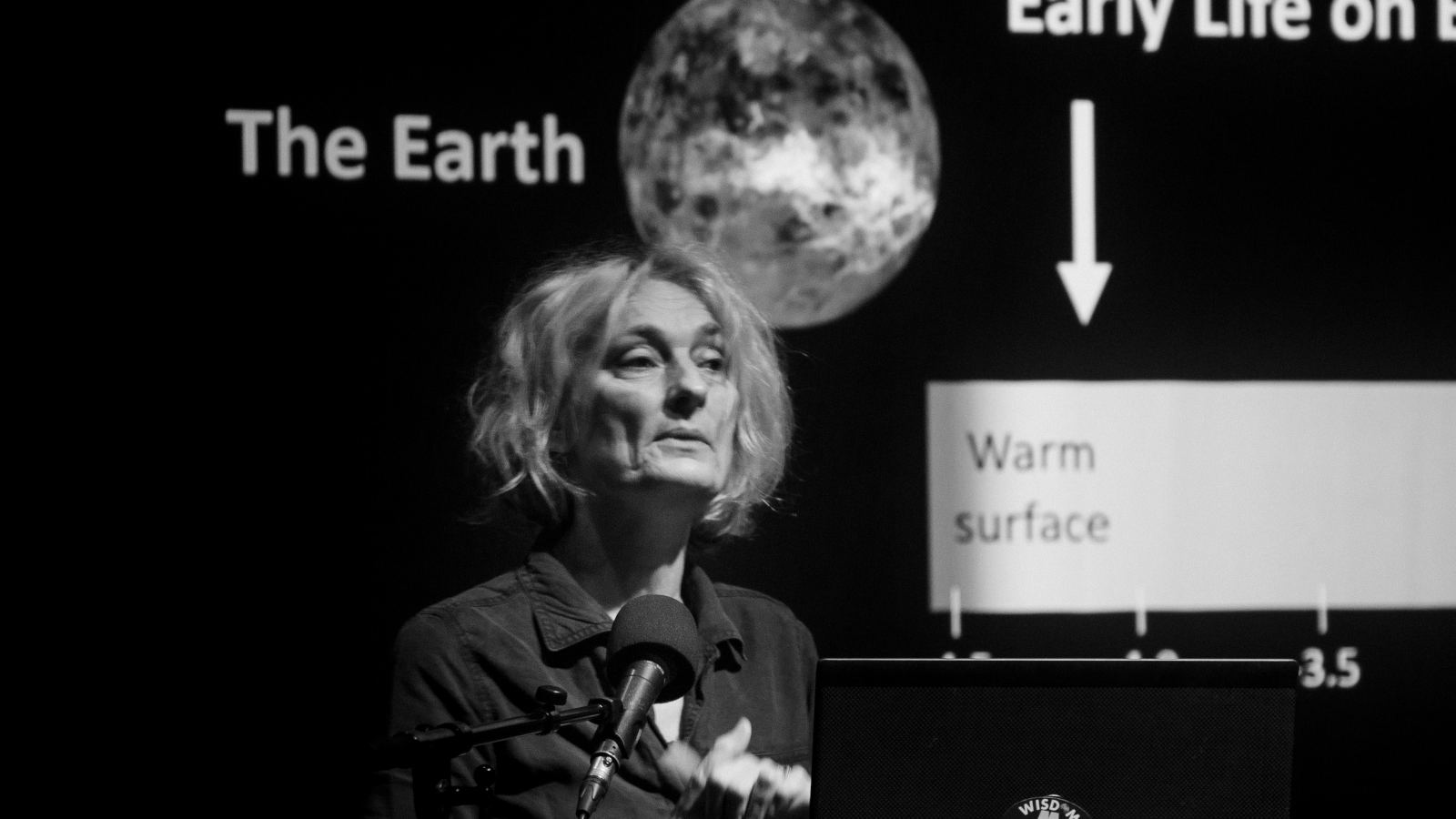
Valérie Ciarletti - image courtesy Mamadou-Gningue-Elisa-Birnie-Scott

Minna Långström - image courtesy Mamadou-Gningue-Elisa-Birnie-Scott

A. Bureaud, Minna Långström, Valérie Ciarletti, M. de Barros - image courtesy Mamadou-Gningue-Lou-Mollet
Organisers & Partners
Research Day co-directed by Annick Bureaud and Manuela de Barros
Co-organised by:
the TEAMeD Laboratory of the University Paris 8 Vincennes-Saint-Denis, the Research University School ArTeC, Leonardo/Olats and the CNEAI
In partnership with:
La Diagonale Paris-Saclay, FEMeeting
With the support of:
Daniel and Nina Carasso Foundation, Canadian Cultural Center in Paris.
This project has received State support run by the Agence Nationale de la Recherche (National Research Agency) in the frame of the Investissements d’avenir programme (Investments for the future) under the reference ANR-17-EURE-0008.


Leonardo/Olats
Observatoire Leonardo des Arts et des Techno-Sciences
À propos / About | Lettre d'information Olats News



Pour toute (re)publication, merci de contacter / For any (re)publication, please contact Annick Bureaud: info@olats.org
Pour toute question concernant le site, merci de contacter / For any issue about the website, please contact: webmaster@olats.org
Design Thierry Fournier
© Association Leonardo 1997-2022